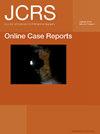Challenging diagnosis and repair of an extensive cyclodialysis cleft
Q4 Medicine
引用次数: 0
Abstract
Introduction: This report describes a challenging case involving the diagnosis and surgical repair of an extensive cyclodialysis cleft (CDC) in a young, phakic patient. Patient and Clinical Findings: A 25-year-old man presented with ocular pain, visual impairment, eyelid hematoma, subconjunctival hemorrhage, and Berlin edema after blunt trauma to the right eye. Initial conservative treatment with medications was converted to surgery due to hypotony-induced maculopathy. Diagnosis, Intervention, and Outcomes: Ultrasound biomicroscopy (UBM) and gonioscopy revealed extensive supraciliary and suprachoroidal fluid and a CDC whose dimensions were inconclusive. However, consequent intraoperative UBM provided precise real-time anatomical evidence of an extensive CDC extending 8 clock hours and mandating closure with a direct cycloplexy approach. Layered scleral dissection and direct suturing of the ciliary body to the sclera were performed with 8-0 nylon sutures, resulting in CDC resolution, supraciliary and suprachoroidal fluid absorption, visual acuity improvement, and intraocular pressure stabilization. Conclusions: This case highlights the innovative use of intraoperative UBM as a critical tool, offering real-time guidance in managing an extensive CDC. The successful closure and improved visual outcomes in this case further validate the efficacy of direct cycloplexy for extensive CDCs.大面积环状透析裂隙的诊断和修复具有挑战性
导言:本报告描述了一个具有挑战性的病例,该病例涉及一名年轻的无晶体眼患者的广泛环透析裂孔 (CDC) 的诊断和手术修复。患者和临床发现:一名 25 岁的男子右眼受到钝性外伤后出现眼痛、视力障碍、眼睑血肿、结膜下出血和柏林水肿。最初采用药物保守治疗,后因低血压诱发黄斑病变而改为手术治疗。诊断、干预和结果:超声生物显微镜(UBM)和眼底镜检查发现了大量睫状体上和脉络膜上积液,CDC的尺寸也无法确定。然而,随后的术中超声生物显微镜检查提供了精确的实时解剖学证据,显示广泛的 CDC 延长了 8 个小时,必须采用直接环形切口的方法进行闭合。使用 8-0 尼龙缝线对巩膜进行了分层剥离并将睫状体直接缝合到巩膜上,从而解决了 CDC 问题,吸收了睫状体上和脉络膜上的液体,改善了视力并稳定了眼压。结论:该病例突出了术中 UBM 作为关键工具的创新应用,为处理广泛的 CDC 提供了实时指导。该病例的成功闭合和视力改善进一步验证了直接环形消融术对广泛性 CDC 的疗效。
本文章由计算机程序翻译,如有差异,请以英文原文为准。
求助全文
约1分钟内获得全文
求助全文

 求助内容:
求助内容: 应助结果提醒方式:
应助结果提醒方式:


